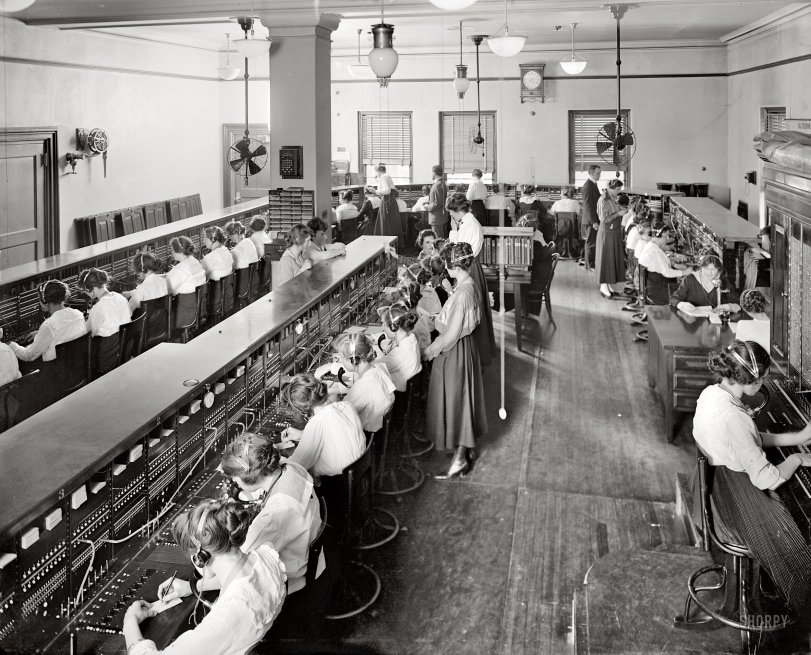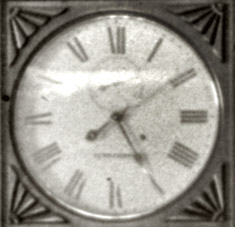


Framed or unframed, desk size to sofa size, printed by us in Arizona and Alabama since 2007. Explore now.
Shorpy is funded by you. Patreon contributors get an ad-free experience.
Learn more.

- Freeze Frame
- Texas Flyer wanted
- Just a Year Too Soon
- WWII -- Replacing men with women at the railroad crossing.
- Yes, Icing
- You kids drive me nuts!
- NOT An Easy Job
- I wonder
- Just add window boxes
- Icing Platform?
- Indiana Harbor Belt abides
- Freezing haze
- Corrections (for those who care)
- C&NW at Nelson
- Fallen Flags
- A dangerous job made worse
- Water Stop
- Passenger trains have right of way over freights?
- Coal
- Never ceases to amaze me.
- Still chuggin' (in model form)
- Great shot
- Westerly Breeze
- For the men, a trapeze
- Tickled
- Sense of loneliness ...
- 2 cents
- Charm City
- What an Outrage
- Brighton Park
Print Emporium
The Operators: 1919

Washington, D.C., circa 1919. "Chesapeake & Potomac Telephone Co. switchboards." Harris & Ewing Collection glass negative. View full size.
My grandmother's best and last memories
My Nan worked as a supervisor at the Bell around this time in Montreal. It was her job to time the operators and see how well they were doing their jobs.
When she was in her late 80s she could remember this like it was yesterday, but she couldn't remember yesterday.
Fantastic picture. Gives me some insight to Grandmother's life.
I did this too.
I worked for AT&T in 1986, first as an overseas operator then on to ship-to-shore with the radio stations WOO, WOM and KMI. These single-pole plug-in cord boards were later replaced with double-pronged International Service Position System boards. The ratio of women to men also changed a little. In my unit, which looked much like this, it was about 2-1 with women still dominating the job. The other people in the unit were usually service assistants who helped the operators and often relieved them to go to the bathroom. In my unit we had dedicated circuits connected to inward operators of countries like Russia, Lebanon, India and Ghana. I totally loved the job! As automation took over, downsizing began, ultimately reducing the force by leaps and bounds.
Buns buns buns!
I love how every girl has the same hairdo, but every single bun is different!
Then vs now
I'm on the phones in the faults department of a larger phone company. We have in our centre a few former plug and switch operators(their job was the same as the ladies above). The only things different from their pics are the fashions and the mouthpiece.
In Australia, full automation of the telephone network did not happen until the mid 1980's, people had to book STD (long distance) calls on busy days like Christmas Day. It's amazing to think that only 25 or so years later, if I need to transfer a call (something that happens often), I just push a couple of buttons on my handset and off they go.
"Three daily recreation periods"
No date, but this Long Lines Operator recruiting brochure looks roughly contemporaneous with the photo and ad.
Thanks Dave
For leaving the title. That "disembowled hand" actually made me howl. Still giggling.
Full Employment
Perhaps we should go back to this way of doing things. Automation is wonderful but it certainly has had an affect on the jobs available for entry-level people. I kind of miss hearing "number please" but don't miss waiting, sometimes hours, to make a long distance call. So, yes, I'm torn between the "good ol' days" and modern conveniences.
Another Family Connection
My mom was an operator for Pacific Bell in the 60s and 70s. Her saddest story was about young men crying as they called their parents before being shipped out to Vietnam. Her funniest story was about how young men would call home on Father's Day, wish their dads a happy day, and then immediately ask for Mom.
Changing times
I noticed in this picture how many people were working. A similar service in this day might involve one person with a computer. Also, everyone is so well dressed. In the pre-polyester days those blouses must have take a lot of ironing to look presentable. Finally, there are so few overweight women in this picture. I think a similar office scene in 2010 would be very different. We have, unfortunately, become fat, frumpy and unemployed.
Disemboweled Hand
Gomez, on the right side of the room -- could that be Thing?
[The word you were thinking of (I dearly hope): "Disembodied." - Dave]
See Miss Gregory
In and Out
Same basic management style existed when I started with Nynex/Bell Atlantic/Verizon in 1987. We also had something similar to the box on the column. It had lights on it that would indicate who was jacked in to the board and who was not -- green in, red out.
Plugs and Jacks
I used to install dial-cord switchboards like these. The last one I did was sometime in the late 1970s for Westinghouse. The doors piled up along the wall were from the backs of the stations, and were usually removed only for running new cables or adding jack strips. On the back of each jack hole you see on those boards were six wires, each stripped and soldered in place. Needless to say, installing these things took plenty of time and patience.
Made for the Long Distance
I was a telephone operator up until 1978. With the exception of the headpiece with the mouth cone, the hair and clothing styles, the room and switchboards looked almost exactly like this. The boards were made extremely well and stood the test of time!
Keeping cool
Can you imagine all these people stuff into this room, working elbow to elbow in their long sleeves and skirts relying on those two fans for comfort when hot humid air hits Washington in the summer. Whew!
And I thought MY job was micromanaged!
I suppose the switchboard watches (one every third girl) were there to time calls.
Lucky Guys
Two men in a room full of young women. Heaven or maybe hell?
One Ringy Dingy
Is this the party to whom I'm speaking?
Time warp?
The clock on the wall reads 7:25 and the small clocks at the operator's stations read 5:10.
[The wall clock says 5:09. - Dave]

Family connection
This is what my mom did in the 1940s for the old AT&T.

























On Shorpy:
Today’s Top 5